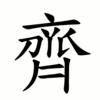齊
| ||||||||
Translingual
| Stroke order | |||
|---|---|---|---|
 | |||
| Traditional | 齊 |
|---|---|
| Shinjitai | 斉 |
| Simplified | 齐 |
Han character
齊 (radical 210, 齊+0, 14 strokes, cangjie input 卜X (YX), four-corner 00223, composition ⿳亠⿲刀丫⿸⿱丿𠄌乀⿲丿二丨)
- Kangxi radical #210, ⿑.
References
- KangXi: page 1531, character 6
- Dai Kanwa Jiten: character 48560
- Dae Jaweon: page 2068, character 11
- Hanyu Da Zidian: volume 7, page 4783, character 1
- Unihan data for U+9F4A
Chinese
Glyph origin
| Historical forms of the character 齊 |
|---|
| Shuowen Jiezi (compiled in Han) |
| Small seal script |
 |
| Characters in the same phonetic series (齊) (Zhengzhang, 2003) | |
|---|---|
| Old Chinese | |
| 儕 | *zriːl |
| 麡 | *zriːl, *ʔsliːl, *zliːl |
| 齋 | *ʔsriːl |
| 穧 | *ʔsleds, *ʔsliːls, *zliːls |
| 擠 | *ʔsliːl, *ʔsliːls |
| 躋 | *ʔsliːl, *ʔsliːls |
| 齏 | *ʔsliːl |
| 齎 | *ʔsliːl, *ʔslil |
| 櫅 | *ʔsliːl |
| 齌 | *ʔsliːl, *sʰliːl, *zliːls |
| 隮 | *ʔsliːl, *ʔsliːls |
| 賷 | *ʔsliːl |
| 虀 | *ʔsliːl |
| 濟 | *ʔsliːlʔ, *ʔsliːls |
| 癠 | *ʔsliːlʔ, *zliːl, *zliːlʔ, *zliːls |
| 霽 | *ʔsliːls |
| 齊 | *zliːl, *zliːls |
| 臍 | *zliːl |
| 蠐 | *zliːl, *zlil |
| 懠 | *zliːl, *zliːls |
| 薺 | *zliːlʔ, *zlil |
| 鱭 | *zliːlʔ |
| 嚌 | *zliːls |
| 劑 | *zliːls, *ʔslel |
| 齍 | *ʔslil |
Ideogram (指事) : a field of grain, hence of uniform height.
Etymology 1
| trad. | 齊 | |
|---|---|---|
| simp. | 齐 | |
| variant forms | 亝 | |
Either related to Mizo čelʔᴸ (“equal, to endure”) or, more phonologically likely, Tibetan [script needed] (tsʰir, “queue, order, succession”) as Tibetan /tsʰir/'s final /-r/ can explain the Middle Chinese retroflex initial of 儕 (OC *zriːl), which is derived from 齊 (OC *zliːl, *zliːls).
Pronunciation 1
Definitions
齊
- even; uniform; of equal length
- 「見賢思齊焉,見不賢而內自省也。」 [Classical Chinese, trad.]
- From: The Analects of Confucius, circa 475 – 221 BCE, translated based on James Legge's version
- “jiàn xián sī qí yān, jiàn bù xián ér nèi zì xǐng yě.” [Pinyin]
- "When we see men of worth, we should think of equaling them; when we see men of a contrary character, we should turn inwards and examine ourselves."
“见贤思齐焉,见不贤而内自省也。” [Classical Chinese, simp.]
- Qi, an ancient Chinese duchy, and later kingdom, during the Zhou dynasty
- the realm of this state under later imperial Chinese dynasties
- A surname.
Compounds
Derived terms from 齊
|
|
|
Pronunciation 2
Pronunciation 3
Pronunciation 4
Compounds
|
|
Pronunciation 5
Compounds
|
|
|
Pronunciation 6
Pronunciation
Compounds
|
References
- (Min Nan) “Entry #10973”, in 臺灣閩南語常用詞辭典 [Dictionary of Frequently-Used Taiwan Minnan] (in Chinese and Min Nan), Ministry of Education, R.O.C., 2011.
Japanese
| 斉 | |
| 齊 |
Kanji
齊
(“Jinmeiyō” kanji used for names, kyūjitai kanji, shinjitai form 斉)
- This term needs a translation to English. Please help out and add a translation, then remove the text
{{rfdef}}.
Korean
Vietnamese
Han character
- This term needs a translation to English. Please help out and add a translation, then remove the text
{{rfdef}}.
References
This article is issued from
Wiktionary.
The text is licensed under Creative
Commons - Attribution - Sharealike.
Additional terms may apply for the media files.